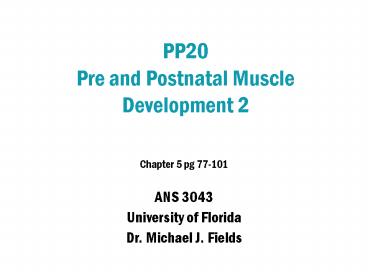PP20 Pre and Postnatal Muscle Development 2 - PowerPoint PPT Presentation
1 / 10
Title:
PP20 Pre and Postnatal Muscle Development 2
Description:
Species dependent and possibly related to state of maturity ... Semimembranosus of hind leg : several billion fibers. Muscle Fibers. Species ... – PowerPoint PPT presentation
Number of Views:29
Avg rating:3.0/5.0
Title: PP20 Pre and Postnatal Muscle Development 2
1
PP20Pre and Postnatal Muscle Development 2
- Chapter 5 pg 77-101
- ANS 3043
- University of Florida
- Dr. Michael J. Fields
2
Myogenesis (continued)
- Muscle Fiber Development
- Occurs during first two thirds of prenatal
development - Almost completed before birth (some postnatal
development) - Species dependent and possibly related to state
of maturity - Pig myofiber numbers established 90-95 days
post-conception - Myofiber numbers do not change in postnatal
period
3
Myogenesis (continued)
- Mechanisms for increasing muscle fiber number
- Prenatal (only significant period when muscle
fiber number can be increased) - Hyperplasia is significant
- Hypertrophy is minimal
- Postnatal
- Hyperplasia is minimal
- Increase in muscle fiber number during this
period is attributed to lengthening of partial
fibers - Satellite cells may contribute to increased fiber
number during muscle regeneration (activated to
proliferate and fuse with other satellite cells
to form new fibers) - Hypertrophy is significant
4
Muscle Fibers
- Factors Affecting Muscle Fiber Development
- Animal Variation
- Muscle fiber number is quite variable for animals
within and between species - Muscles within an animal
- Muscles exist in numerous sizes and shapes
- Eye few thousand fibers
- Semimembranosus of hind leg several billion
fibers
5
Muscle Fibers
- Species
- Differences in body size is related to number of
muscle fibers (i.e. increased muscle mass between
elephant and mouse due to increased muscle
fibers) - Excess growth in muscle diameter is not favorable
from a metabolic standpoint - Diffusion of nutrients and metabolites in and out
of a muscle fiber is restricted if radial growth
of fiber is excessive
6
(No Transcript)
7
Muscle Fibers
- Nutrition
- Greater impact on muscle at some stages of growth
than others - Can alter muscle number only during prenatal
period - Severe nutrient restriction dramatically
suppresses muscle fiber formation resulting in
runt pigs at birth (failure of secondary muscle
fiber development during gestation) - If runts survive they become fatter with less
muscle than litter mates - Postnatal depravation has little effect on muscle
fiber number
8
Muscle Fibers
- Age
- Number of muscle fibers is fixed at birth and
does not usually change with age - Age related changes only occur in utero and only
during early and mid pregnancy - Most mammals and avian species are determinant
growers reach a specific mature size provided
adequate nutrition
9
Muscle Fibers
- Fish are indeterminate growers no predetermined
mature size - Grow to a size reflective of nutrients in their
environment - Capable of generating new fibers after hatching,
which contributes significantly to overall
hypertrophy of muscle
10
Muscle Fibers
- Senescence process of growing old
- Muscle is not completely regenerated (fewer
satellite cells) - Protein degradation gt Protein synthesis
- Results in loss of muscle mass and muscle fiber
number - Not relevant in meat-producing animals, but
apparent in breeding stock and companion animals
that reach older ages - Cause is unclear but possibly associated with
losses of neuronal input - Associated with muscle wasting in elderly humans
- Use it or lose it principle































